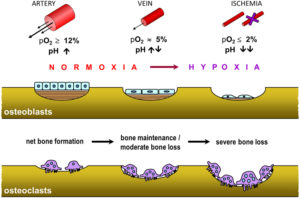What can we discern about the plans from LSJL from the grants? Yokota is one of the primary scientists behind the study Lengthening of Mouse Hindlimbs with Joint Loading. There does not seem to be very much on the LSJL length effects since the expiring of Ping Zhang’s 2010 grant. We either have to study the lengthening effects on our own or help Ping Zhang get more funding.
Yokota doesn’t mainly study the lengthening effects which are primarily studied by Ping Zhang as shown by this grant.
Here’s Hiroki Yokota’s 2015 grant:
“The long-term objective of the proposed studies is to elucidate the mechanism of mechanotransduction in bone. Our present bioengineering-oriented project developed a high-resolution piezoelectric mechanical loader and evaluated the role of mechanical stimulation in bone using cultured osteoblasts. The results reveal that (a) deformation of 3D collagen matrix can induce strain-induced fluid flow;(b) strain-induced fluid flow, and not strain itself, predominantly activates the stress-responsive genes in osteoblasts;and (c) architecture of 3D collagen matrix establishes a pattern of strain-induced fluid flow and molecular transport{We are not interested so much on the effects on osteoblasts but more on the effects of fluid flow on bone degradation and fluid flow on mesenchymal stem cells to create neo growth plates}. Many lines of evidence in animal studies support enhancement of bone remodeling with strain of 1000 – 2000 microstrains. An unclear linkage between our in vitro studies and these animal studies is the role of strain and fluid flow in bone remodeling. In vitro osteoblast cultures including our current studies use 2D substrates or 3D matrices that hardly mimic the strain-induced fluid flow in vivo. This difference between in vitro and in vivo data makes it difficult to evaluate the role of strain and fluid flow in bone remodeling and anti-inflammation. First, microscopic strain in bone might be higher than the macroscopic strain measured with strain gauges. A local microscopic strain higher than 1000 – 2000 microstrains may therefore drive fluid flow in bone. Second, the lacunocanalicular network in bone could amplify strain-induced fluid flow in a loading-frequency dependent fashion{This we should try to modify the frequency of LSJL to amplify strain}. Lastly, interstitial fluid flow in bone might be induced by in situ strain as well as strain in a distant location, such that deformation of relatively soft epiphyses induces fluid flow in cortical bone in diaphyses{We are more interested in deformation of the epiphysis as that’s where growth plates typically occur but deformation of the epiphysis in one end may induce fluid flow in the epiphysis in the other}. This renewal proposal will use mouse ulnae ex vivo as well as mouse in vivo loading to examine the above possible explanations for the data divergence.
Specific aims i nclude: (1) fabricating a piezoelectric mechanical loader for ex vivo and in vivo use;(2) quantifying ex vivo macroscopic and microscopic strains using electronic speckle pattern interferometry as well as molecular transport using fluorescence recovery after photobleaching;(3) conducting bone histomorphometry to evaluate ex vivo data;and (4) examining load-driven adverse effects with gene expression and enzyme activities (e.g., matrix metalloproteinases). Mechanical loads will be given in the ulna-loading (axial loading) and elbow-loading (lateral loading) modes{he’s planning on doing another LSJL loading study!}. These two modes have been shown to enhance bone remodeling in the diaphysis with different patterns of strain distribution. Successful completion of the proposed renewal proposal will provide basic knowledge about induction of fluid flow in bone and establish a research platform for devising therapeutic strategies for strengthening bone and preventing bone loss.”
Here’s the Hiroki Yokota 2014 grant:
Mechanical Loading and Bone
“The long-term objective of this study is to elucidate the mechanisms underlying loading-induced bone remodeling and develop unique loading-based therapies for preventing bone loss. The specific goal of this study, based on our most recent observations, is to determine how mechanical loading to the knee (knee loading – application of mild lateral loads to the knee) may exert global suppression of osteoclast development not only in the loaded (on-site) bone but also in the non-loaded (remote) bone{This is unfortunately not very promising for height growth as osteoclast driven remodeling is pretty significant for growth plate formation}. As a potential regulatory mechanism, we will focus on secretory factors (e.g., Wnt3a, NGF?, TNF?, etc.) and low-density lipoprotein receptor-related protein 5 (Lrp5) mediated signaling. In the parent project, we have shown that knee loading enhances bone formation in the tibia and the femur through the oscillatory modulation of intramedullary pressure. However, its effects on bone resorption have not been well understood. Preliminary studies using a mouse ovariectomized model, which mimics post-menopausal osteoporosis, indicate that knee loading can suppress development of multi-nucleated osteoclasts from bone marrow cells, and the loading effects are observed not only in the loaded femur but also in the non-loaded contralateral femur. In this competitive renewal project, we will test the hypothesis that joint loading (knee/elbow loading) can suppress an OVX-induced osteoclastogenesis in a systemic manner through Lrp5-mediated Wnt signaling with Wnt3a as a secretory factor, as well as interactions with other secretory factors. To examine this hypothesis, we propose two specific aims using a mouse loading model (knee loading, elbow loading, ulna bending, and tibia loading), and assays for bone remodeling and primary bone marrow cells.
Aim 1 : Determine the local and global effects of joint loading on osteoclastogenesis Aim 2: Evaluate the role of load-modulated secretory factors in osteoclastogenesis In response to mechanical loading, we will conduct X-ray imaging and colony forming unit assays{The x-rays will be highly useful in determining whether LSJL can induce neo-growth plate formation although the effects would have to be large to show up on the xray}. We will also examine expression of critical secretory factors such as Wnt3a, NGF?, TNF?, OPG, RANKL, etc. in the serum. Primary bone marrow cells will be cultured, and the mechanisms underlying loading-driven regulation of osteoclastogenesis will be investigated. We will examine expression of regulatory factors, including NFATc1 (master transcription factor for osteoclastogenesis) and osteoclast markers such as OSCAR, cathepsin K, etc. We will employ Lrp5 KO mice (global, and conditionally selective to osteocytes), as well as neutralizing antibodies and RNA interference (loss of a function), and plasmids (gain of a function). We expect that this project will contribute to our basic understanding of load-driven regulation of bone resorption and development of loading regimens useful for global prevention of bone loss. ”
Let’s look at Hiroki Yokota’s 2013 Grant:
“The long-term objective of the proposed studies is to elucidate the mechanism of mechanotransduction in bone. Our present bioengineering-oriented project developed a high-resolution piezoelectric mechanical loader and evaluated the role of mechanical stimulation in bone using cultured osteoblasts. The results reveal that (a) deformation of 3D collagen matrix can induce strain-induced fluid flow{If it is fluid flow that can induce neo-growth plate formation via stem cell simulation then we need to make sure that LSJL deforms the 3D collagen matrix};(b) strain-induced fluid flow, and not strain itself, predominantly activates the stress-responsive genes in osteoblasts;and (c) architecture of 3D collagen matrix establishes a pattern of strain-induced fluid flow and molecular transport. Many lines of evidence in animal studies support enhancement of bone remodeling with strain of 1000 – 2000 microstrains{2000 microstrain is about a 0.2% change in bone length. LSJL laterally compresses the bone so the compression has to be by at least .1 or .2% to work}. An unclear linkage between our in vitro studies and these animal studies is the role of strain and fluid flow in bone remodeling. In vitro osteoblast cultures including our current studies use 2D substrates or 3D matrices that hardly mimic the strain-induced fluid flow in vivo. This difference between in vitro and in vivo data makes it difficult to evaluate the role of strain and fluid flow in bone remodeling and anti-inflammation. First, microscopic strain in bone might be higher than the macroscopic strain measured with strain gauges. A local microscopic strain higher than 1000 – 2000 microstrains may therefore drive fluid flow in bone. Second, the lacunocanalicular network in bone could amplify strain-induced fluid flow in a loading-frequency dependent fashion. Lastly, interstitial fluid flow in bone might be induced by in situ strain as well as strain in a distant location, such that deformation of relatively soft epiphyses induces fluid flow in cortical bone in diaphyses{of course our goal is to create new growth plates in the epiphysis but the fluid flow from compressing the ends of the epiphysis may flow deeper helping to induce mesenchymal condensation to induce neo growth plates closer to where the epiphysis meets the diaphysis}. This renewal proposal will use mouse ulnae ex vivo as well as mouse in vivo loading to examine the above possible explanations for the data divergence.
Specific aims include: (1) fabricating a piezoelectric mechanical loader for ex vivo and in vivo use;(2) quantifying ex vivo macroscopic and microscopic strains using electronic speckle pattern interferometry as well as molecular transport using fluorescence recovery after photobleaching;(3) conducting bone histomorphometry to evaluate ex vivo data;and (4) examining load-driven adverse effects with gene expression and enzyme activities (e.g., matrix metalloproteinases). Mechanical loads will be given in the ulna-loading (axial loading) and elbow-loading (lateral loading) modes. These two modes have been shown to enhance bone remodeling in the diaphysis with different patterns of strain distribution. Successful completion of the proposed renewal proposal will provide basic knowledge about induction of fluid flow in bone and establish a research platform for devising therapeutic strategies for strengthening bone and preventing bone loss. ”
The grants from 2013-2006 are virtually the same. It’s only 2014 which is different however it’s unfortunate that it’s not focusing on the lengthening effects.
Unfortunately Ping Zhang’s grant Load-Driven Bone Lengthening only ran from 2008-2010.



